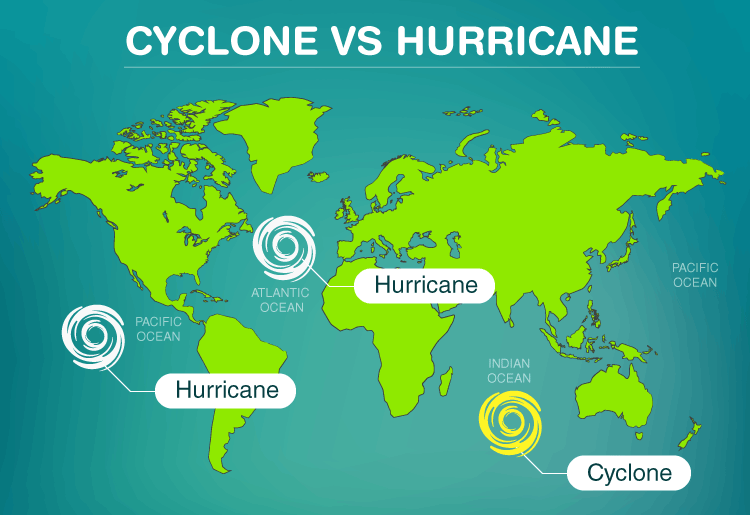A hurricane is a tropical system that originates in the Atlantic and Northeast Pacific oceans, whereas a cyclone originates in the north Indian Ocean.
Here are some key distinctions between cyclones and hurricanes to help you learn how they differ:
Hurricane Vs Cyclone:
What is Hurricanes?
A hurricane is a category of severe weather.
A tropical storm becomes a hurricane when its wind speed exceeds 74 miles per hour.
The center of a hurricane is generally the area with the lowest pressure; this is referred to as the storm’s “eye.”
The evaporation of seawater increases their strength.
In the Northern Hemisphere, these spin anticlockwise around an “eye.” In the Southern Hemisphere, they rotate counter clockwise.
Hurricane can cause significant damage owing to torrential rain, high gusts, and enormous waves as compare to cyclone.
What is Cyclone?
The spinning storm that revolves around the low-pressure core is referred to as a cyclone.
Stormy atmospheric systems are referred to as cyclones. This low-pressure area is often known as the storm’s “eye.”
This is related to the instability of atmospheric conditions. Storms are classified as typhoons or hurricanes based on their location and ferocity.
Cyclones are classified into three types: tropical cyclones, extratropical cyclones, and tornadoes.

What is Difference between Cyclone and a Hurricane?
A hurricane is a storm system that revolves around low pressure and produces high winds and heavy rain whereas a cyclone is a generic word for a meteorological system in which winds circle inward to a low-pressure region.
So, what’s the difference? Let’s discuss the difference between hurricanes and cyclones and how they are similar but not the same.
| Hurricanes | Cyclone |
| Hurricane is enormous spinning storms that form over warm ocean waters and are a kind of tropical cyclone. | A cyclone is a fast-moving disaster characterized by high winds, heavy rain, and low air pressure that arises over warm tropical oceans. |
| They inhabit the North Atlantic and Northeast Pacific Oceans. | They are found in the south-eastern Indian and southwestern Pacific oceans. |
| Hurricanes have the greatest impact on the Caribbean Sea Region. | Cyclones have had the greatest impact on India, North-west Australia, Bangladesh, and the Indian Ocean islands of Mauritius and Madagascar. |
| The greatest sustained wind speed of a hurricane exceeds 74 mph. | Tropical depressions are cyclones with surface winds less than 39 mph, whereas tropical storms have maximum sustained winds of 39 mph or greater. |
| In the Southern Hemisphere, it rotates clockwise, whereas, in the Northern Hemisphere, it rotates anticlockwise. | In the Southern Hemisphere, it rotates clockwise, whereas, in the Northern Hemisphere, it rotates anticlockwise. |
Conclusion:
As a result of a thorough discussion of the two concepts, you should have a clear understanding of hurricane and cyclone.
Pulse-Doppler radar, photogrammetry, and ground swirl patterns are used to identify cyclones and hurricanes.
Every year, there seem to be 10-14 cyclones. Hurricanes strike the Atlantic Ocean roughly five or six times every year.
• Section Under Diff